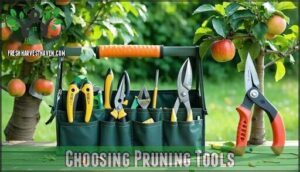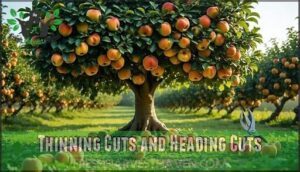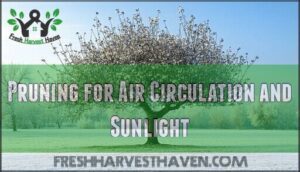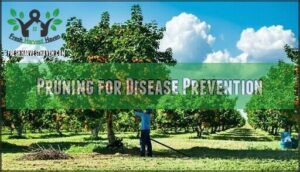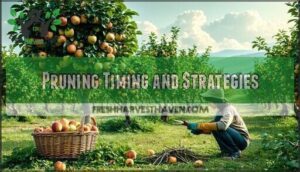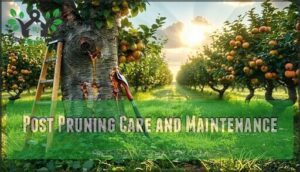This site is supported by our readers. We may earn a commission, at no cost to you, if you purchase through links.
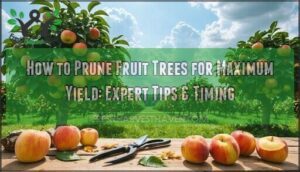
Start by removing dead, diseased, or crossing branches during the dormant season – typically late winter before bud break.
Then focus on thinning cuts to open the canopy for sunlight penetration and air circulation. Make clean cuts just above outward-facing buds to encourage proper growth direction.
Different fruit trees require specific approaches – stone fruits like peaches need more aggressive pruning than apples. The key is balancing vegetative growth with fruit production through strategic branch removal.
Understanding the relationship between pruning severity and fruiting patterns can transform your harvest from disappointing to abundant, achieving maximum yield.
Table Of Contents
- Key Takeaways
- Pruning Benefits Explained
- How to Prune Fruit Trees
- Choosing Pruning Tools
- Pruning Techniques for Yield
- Pruning Different Fruit Trees
- Pruning Timing and Strategies
- Post Pruning Care and Maintenance
- Frequently Asked Questions (FAQs)
- How to prune fruit trees for production?
- What is the 123 rule of pruning?
- How to increase fruit tree yield?
- How do you prune fruit trees to produce more fruit?
- How do you increase the yield of a fruit tree?
- What is the 1 3 rule for tree pruning?
- When should you not prune fruit trees?
- What is the 1 3 rule for pruning trees?
- Should you prune fruit trees?
- What are the benefits of pruning a fruit tree?
- Conclusion
Key Takeaways
- Time your pruning during dormancy – Prune in late winter before bud break to minimize disease risk and maximize energy redirection toward fruit production
- Remove the "three D’s" first – Always start by cutting out dead, diseased, and damaged wood to prevent pathogen spread and focus tree energy on healthy growth
- Use thinning cuts over heading cuts – Remove entire branches at their origin to open the canopy for better sunlight penetration and air circulation rather than just shortening branches
- Adapt techniques to tree type – Apple and pear trees need central leader training, while stone fruits like peaches perform better with open-center pruning for optimal yields
Pruning Benefits Explained
Proper pruning transforms your fruit trees into productive powerhouses by directing energy toward high-quality fruit production rather than unnecessary growth.
Strategic cuts unlock your tree’s hidden harvest potential – every branch matters.
You’ll see immediate benefits in tree health, disease resistance, and long-term yield potential when you master these essential techniques, which can make your fruit trees into productive** powerhouses.
Importance of Pruning for Fruit Yield
By strategically removing branches, you’ll release your tree’s potential for maximum yield techniques.
Proper pruning basics redirect energy toward fruit production rather than excessive foliage growth.
Here’s how pruning for yield transforms your harvest:
- Larger, higher-quality fruits develop when trees focus energy on fewer branches
- Enhanced sunlight penetration reaches interior fruiting wood for better ripening
- Improved air circulation reduces disease pressure that limits productivity
- Stronger branch structure supports heavier fruit loads without breaking
- Consistent annual harvests replace unpredictable boom-bust cycles
This yield optimization strategy extends tree longevity while dramatically improving fruit quality and harvest management efficiency.
Benefits of Pruning for Tree Health
The foundation of tree health begins with strategic pruning for tree health.
You’ll remove dead, diseased, and damaged wood that harbors pathogens and pests.
This pruning technique improves airflow and sunlight penetration, creating an environment hostile to fungal infections while boosting fruit quality and tree longevity.
| Health Benefit | Impact on Tree |
|---|---|
| Disease Control | Removes infected wood, prevents spread |
| Improved Airflow | Reduces fungal growth, pest hideouts |
| Enhanced Light | Strengthens branches, better photosynthesis |
Aesthetic Benefits of Pruning
Well-shaped trees transform your garden into a showcase. Tree shaping through strategic pruning creates visual balance and landscape enhancement that neighbors admire.
Consider these aesthetic advantages:
- Structured canopies provide elegant fruit display while maintaining garden design harmony
- Balanced proportions enhance property value through improved tree structure and visual appeal
- Clean lines integrate seamlessly with landscape features, showcasing your pruning techniques mastery
Smart pruning for tree structure improvement delivers both beauty and function in your orchard. Effective use of pruning techniques is vital for achieving superior results and maximizing fruit yield.
How to Prune Fruit Trees
Successful pruning starts with understanding your tree’s specific needs and establishing clear goals. You’re shaping more than branches – you’re directing energy flow and maximizing fruit production through strategic cuts.
Master these Pruning Basics to transform your orchard:
- Remove the "three D’s": dead, diseased, and damaged wood first
- Open the canopy for better air circulation and sunlight penetration
- Focus energy on productive branches through selective thinning
Fruit Quality improves dramatically when you apply proper Tree Training techniques. Different Pruning Systems work better for specific species – apples thrive with central leaders while peaches prefer open centers. Your fruit tree pruning approach should align with natural growth patterns.
When you prune fruit trees correctly, you’re setting up next season’s Harvest Optimization success story. Proper pruning techniques are essential for maintaining healthy and productive trees, which is crucial for achieving better air circulation and maximizing fruit production through the right pruning approach.
Choosing Pruning Tools
The right tools make the difference between clean, healing cuts and ragged wounds that invite disease.
You’ll need sharp, well-maintained equipment sized properly for each branch to guarantee your fruit trees stay healthy and productive.
Hand Pruners and Loppers
Your essential hand tools make or break your pruning success. Bypass pruners handle branches up to ¾-inch thick with clean, precise cuts that heal faster than crushing anvil-style cuts.
Choose ergonomic handles that fit comfortably in your grip—you’ll thank yourself during longer sessions. Loppers extend your reach and leverage for 1-2 inch branches.
Sharp tools prevent bark tearing and disease entry points, so invest in quality bypass pruners and maintain proper tool sharpening for effective cutting techniques and pruning safety.
When selecting the right tools, consider using high quality pruners to achieve the best results.
Saws and Pole Pruners
When loppers can’t handle the job, pruning saws and pole pruners step in for branches over two inches thick.
A sharp hand saw cuts through thick limbs cleanly, while pole pruners extend your reach to high branches safely.
Choose pruning saws with curved blades for fruit trees—they cut faster and create smoother wounds.
Regular blade maintenance keeps cutting tools effective, and sturdy pruning handles provide better control during heavy pruning work.
Understanding proper pruning techniques is essential for efficient pruning, and you can find more information on pruning saw techniques.
Tool Maintenance and Safety
Proper maintenance transforms pruning tools from garden chores into precision instruments. Sharp tools make cleaner cuts that heal faster, while clean equipment prevents disease transmission between trees.
Essential maintenance steps for pruning safety:
- Tool sanitizing with rubbing alcohol between trees prevents pathogen spread
- Regular sharpening keeps pruning shears and pole pruners cutting efficiently
- Oil moving parts monthly to prevent rust and guarantee smooth operation
- Hand protection through proper gloves reduces injury risk during maintenance
Sterilization isn’t optional—it’s your first line of defense against spreading infections throughout your orchard.
Pruning Techniques for Yield
You’ll maximize your fruit harvest by mastering two key cutting techniques that control where and how your trees grow.
Strategic pruning creates the perfect environment for fruit development while preventing the diseases that can destroy your entire crop.
Thinning Cuts and Heading Cuts
Understanding thinning cuts versus heading cuts transforms your approach to tree shaping.
Thinning cuts remove entire branches at their origin, opening the canopy for better fruit enhancement.
Heading cuts shorten branches partway back, stimulating dense regrowth.
You’ll use thinning cuts primarily for branch reduction and air circulation, while heading cuts help control tree size and direct growth patterns in young trees.
Pruning for Air Circulation and Sunlight
Maximizing fruit yield starts with strategic canopy management that transforms dense, shadowy branches into productive powerhouses. Proper branch thinning creates pathways for essential sunlight penetration and air circulation throughout your tree’s structure.
Consider these key pruning techniques for ideal fruit exposure:
- Remove crossing branches that block sunlight from reaching interior fruiting wood
- Thin crowded areas to allow 33-50% more light into the canopy center
- Space remaining branches 6-8 inches apart for proper air circulation
- Open up dense upper growth to prevent shading lower productive branches
- Focus on outward-facing cuts that guide growth away from the tree’s center to achieve proper air circulation and promote healthy growth.
By following these guidelines, you can improve the overall health and productivity of your tree, leading to a more bountiful harvest.
Pruning for Disease Prevention
Disease prevention starts with removing infected branches immediately—studies show this cuts fire blight by 60%.
Tool sterilization between cuts prevents pathogen spread, while improved airflow from strategic pruning reduces humidity that fuels fungal growth.
Clean cuts during dry, dormant periods minimize infection risk.
Bacterial management and fungal control become effortless when you combine proper sanitation practices with targeted removal of crossing branches that create wounds.
Pruning Different Fruit Trees
Different fruit trees require specific pruning approaches to maximize yield and maintain healthy growth patterns.
You’ll need to adapt your techniques based on whether you’re working with apples, cherries, stone fruits, or other varieties since each has unique fruiting habits and structural needs.
Pruning Apple and Pear Trees
Apple and pear trees thrive with a central leader system that creates strong tree structure.
These species respond well to dormant pruning during late winter, which maximizes fruit production while minimizing disease risk.
- Establish central leader training with evenly spaced scaffold branches at 45-60° angles
- Remove water sprouts and crossing branches that compete for resources and sunlight
- Preserve fruiting spurs since they produce for 5-10 years and drive harvest optimization
- Make clean pruning cuts to prevent disease while directing energy toward productive growth
Pruning Cherry and Peach Trees
Properly pruning cherry trees and pruning peach trees dramatically boosts your harvest. Both benefit from open-center tree shaping for ideal sunlight penetration and airflow.
Sweet cherries need summer prune timing to prevent bacterial canker, while peaches thrive with late winter cuts.
| Aspect | Cherry Trees | Peach Trees |
|---|---|---|
| Best Timing | Mid-summer (dry weather) | Late winter before bud swell |
| Structure Goal | Open center with light pruning | Vase shape with heavy annual cuts |
| Wood Removal | Maximum 20% per season | Remove 40-50% of previous year’s growth |
| Disease Prevention | Avoid winter cuts (bleeding sap) | Reduce humidity through fruit thinning |
| Yield Impact | 18-22% increase with regular care | Larger fruit (15-20g heavier per peach) |
Pruning Apricot and Plum Trees
Why struggle with apricots and plums when proper pruning for maximum yield transforms difficult trees into productive powerhouses? These stone fruits demand specific tree pruning techniques for ideal harvest optimization.
Pruning Basics for apricots focus on spur thinning, while plums require aggressive watersprout control through strategic branch removal.
- Fruit thinning apricot spurs prevents branch breakage and improves fruit size
- Remove plum watersprouts immediately to redirect energy toward productive branches
- Use modified central leader tree shaping for both species’ structural integrity
- Practice annual fruit tree care with selective thinning cuts over heading cuts
Pruning Timing and Strategies
Timing your pruning correctly transforms how your fruit trees perform each season.
You’ll discover that the right approach varies between young trees establishing their framework and mature trees focused on maximum production.
Pruning in Spring and Summer
Spring pruning and summer care release your fruit trees’ maximum potential.
Strategic pruning techniques during these active growing seasons direct energy toward fruit development while maintaining ideal tree structure.
- Spring pruning before bud break reduces infection risk while promoting vigorous growth
- Fruit thinning in early summer increases remaining fruit size and prevents branch breakage
- Water sprout removal eliminates energy-wasting shoots competing with productive branches
- Summer pruning controls tree size and encourages flower bud formation for next season
- Disease prevention through improved airflow and sunlight penetration reduces fungal issues
Tree training during spring establishes strong frameworks, while summer care focuses on maintaining balance between vegetative growth and fruit production for maximum yield.
Pruning in Fall and Winter
During winter’s quiet months, you’ll master dormant pruning when trees rest completely.
Winter pruning offers perfect timing for structural work—branches stand bare, revealing the tree’s true architecture.
Focus on dormant season cuts that heal efficiently while avoiding frost damage to fresh wounds.
Remember, fall pruning should remain minimal since new growth won’t harden before cold weather arrives.
Sterilized tools prevent disease spread during winter care, ensuring your pruning for maximum yield sets the foundation for next season’s abundant harvest.
Pruning for Young and Mature Trees
Since young trees require different care than mature ones, your pruning approach should adapt accordingly.
Focus on scaffold branching and branch training during the first five years to establish strong structure for future fruit production.
Young trees need formative pruning cuts to develop central leaders, while mature trees benefit from tree renewal techniques that maintain productive wood and optimize tree growth for sustained yield.
Proper pruning techniques involve understanding pruning basics to guarantee healthy tree development and maximum fruit yield.
Post Pruning Care and Maintenance
You’ve just made the cuts, but your work isn’t finished—proper post-pruning care determines whether your tree thrives or struggles in the coming season.
The right follow-up steps protect fresh wounds, boost recovery, and set the stage for maximum fruit production.
Wound Care and Protection
Proper wound care after pruning maximizes fruit yield by preventing infections. Clean cuts heal faster than ragged ones, protecting your investment.
Cut Healing depends on these four factors:
- Make clean, angled cuts at 45° away from buds for ideal wound healing
- Disinfect tools with 70% alcohol between cuts to prevent disease spread
- Avoid wound sealants – they trap moisture and delay natural bark repair
- Prune during dry conditions to accelerate callus formation and reduce fungal prevention needs
Research shows pruning cuts larger than 2.5 cm face 70% higher infection risk without proper care. Your trees naturally compartmentalize wounds through tree wound healing processes, making postpruning care about supporting, not hindering, recovery. Tree bandages aren’t recommended – trust nature’s wound sealing abilities instead.
Fertilization and Watering
After pruning, wait 2-3 weeks before fertilizing to avoid stressing healing cuts.
Use slow-release fertilizer matched to your soil pH and nutrient balance needs. Deep, weekly watering supports recovery better than frequent shallow sessions.
Test soil nutrition annually and adjust fertilization practices based on results. Quality irrigation methods and proper fertilizer types promote healthy water quality and meet specific soil requirements.
For optimal growth, consider using slow release formulations that promote healthy plant development.
Pest and Disease Management
Fresh wounds attract trouble like magnets draw metal.
**Proper care turns potential disasters into thriving harvests.
After pruning, your trees become vulnerable battlegrounds where pests and diseases wage war against your harvest dreams.
Protect your investment with these organic methods:
- Neem oil applications create invisible shields against aphids, scale, and fungal spores
- Copper fungicides act as sentinels, preventing bacterial canker and fire blight infections
- Beneficial insects become your orchard’s natural army, devouring harmful pests
Monitor pruning cuts daily for the first week—early detection means swift biological management before problems escalate into yield-crushing disasters.
Seasonal Pruning Considerations
Timing transforms your fruit trees into productive powerhouses.
Dormant pruning during late winter encourages vigorous spring growth and fruit set, while summer pruning controls excess vigor and maintains tree shape.
Avoid fall cuts that stimulate tender growth vulnerable to frost damage.
Master these pruning schedules for maximum yield.
Understanding proper pruning techniques is essential for achieving superior results and maximizing fruit production.
Frequently Asked Questions (FAQs)
How to prune fruit trees for production?
Looking at your question about pruning fruit trees for production, here’s my 35-word answer: Want better harvests?
Prune during dormancy using sharp, clean tools.
Remove dead wood first, then thin crowded branches.
Apple trees need central leaders; peaches prefer open centers.
Annual pruning boosts yields substantially.
What is the 123 rule of pruning?
The "1-2-3 rule" isn’t a standard pruning principle.
You might be thinking of the 3-cut technique for removing large branches: undercut first, top cut second, final cut third.
This prevents bark stripping and guarantees clean, healing-friendly cuts that protect your tree’s health.
How to increase fruit tree yield?
Dramatically boost your harvest by pruning during dormancy, removing 15-30% of wood annually. Focus on dead, diseased branches first, then thin crowded areas for better sunlight penetration and airflow.
How do you prune fruit trees to produce more fruit?
Prune during dormancy (late winter/early spring) to minimize disease risk.
Remove dead, diseased, and crowded branches first.
Use thinning cuts over heading cuts to improve airflow and sunlight penetration, directing energy toward fruit production.
How do you increase the yield of a fruit tree?
Picture sunlight streaming through well-spaced branches, energizing every fruit.
You’ll maximize yield through strategic dormant-season pruning, removing 15-30% of wood annually.
Focus on thinning crowded branches, eliminating diseased wood, and maintaining proper tree structure for ideal light penetration and airflow.
What is the 1 3 rule for tree pruning?
Never remove more than one-third of a tree’s living branches in a single year.
This guideline prevents shock, maintains healthy growth, and guarantees your fruit tree can recover while still producing quality fruit.
When should you not prune fruit trees?
You shouldn’t prune fruit trees in late fall or early winter, since cuts won’t heal well and cold snaps can damage new growth.
Skip heavy pruning during bloom or fruit set, too—let the tree focus on fruit production.
What is the 1 3 rule for pruning trees?
Ideal pruning removes only 15-30% of wood annually to maximize fruit production.
The 1/3 rule prevents over-pruning by limiting branch removal to one-third of total growth, ensuring trees maintain energy reserves for robust flowering and fruiting cycles, which is crucial for fruit production.
Should you prune fruit trees?
Yes, you should absolutely prune fruit trees. Regular pruning boosts yields, improves fruit quality, prevents disease, enhances airflow, and maintains manageable tree size for easier harvesting and care.
What are the benefits of pruning a fruit tree?
Like a gardener’s gentle hand guiding nature’s potential, pruning frees your tree’s hidden productivity by removing diseased wood, improving sunlight penetration, enhancing airflow, strengthening branches, and redirecting energy toward quality fruit production rather than excessive foliage growth.
Conclusion
Ready to transform next year’s harvest? Mastering how to prune fruit trees for maximum yield requires consistent practice and seasonal awareness.
Remember that timing matters more than perfection—late winter pruning during dormancy sets the foundation for abundant fruit production.
Each cut you make shapes your tree’s future, balancing vegetative growth with fruiting potential. Start small, observe your tree’s response, and adjust your technique accordingly.
With proper pruning methods, you’ll achieve healthier trees and substantially improved yields season after season.

